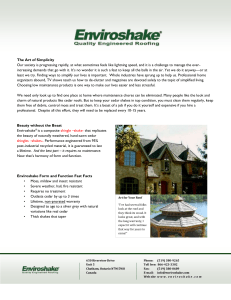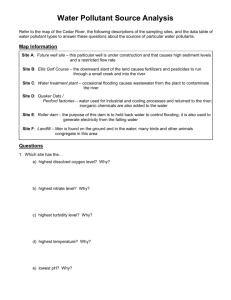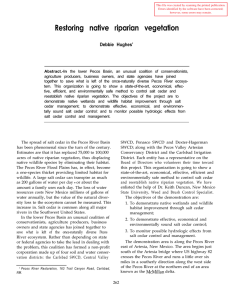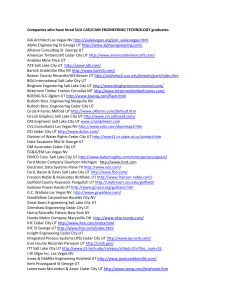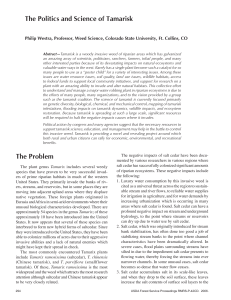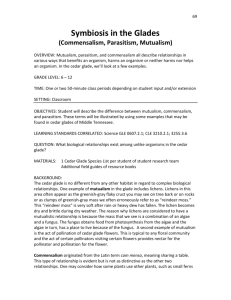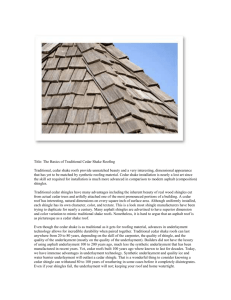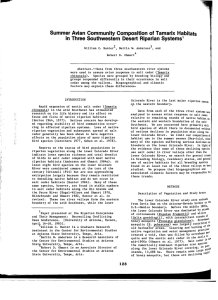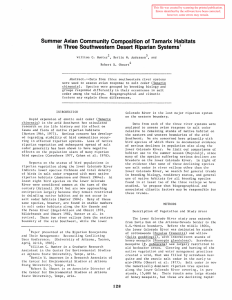Salt Cedar Introduction - Johnson County Weed & Pest
advertisement
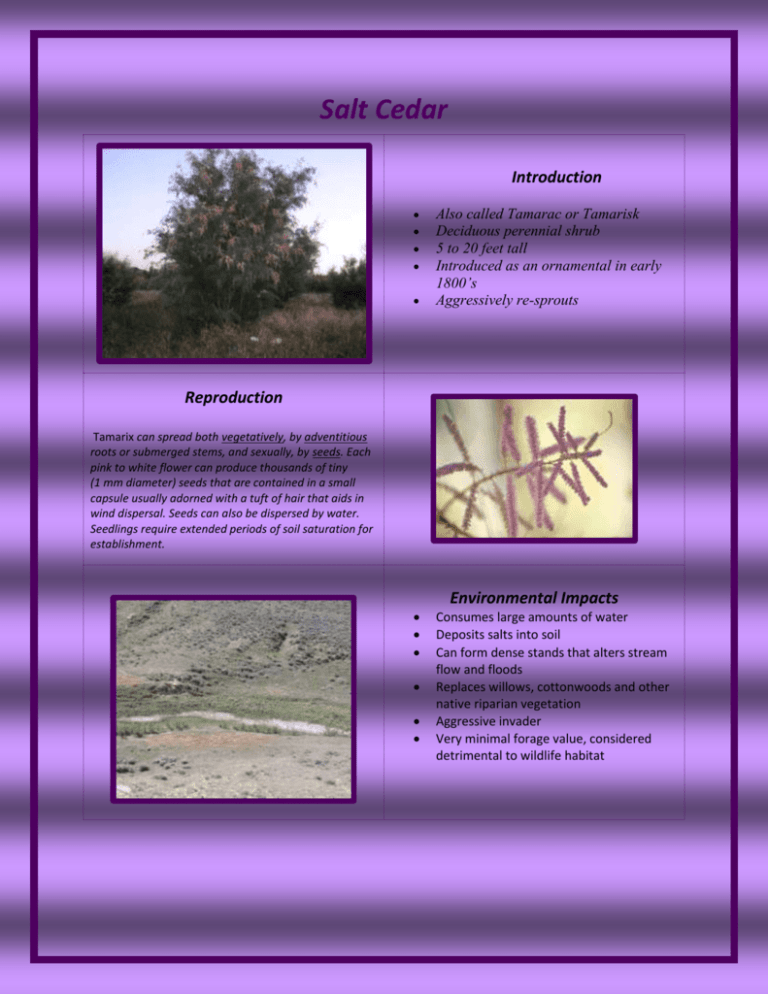
Salt Cedar Introduction Also called Tamarac or Tamarisk Deciduous perennial shrub 5 to 20 feet tall Introduced as an ornamental in early 1800’s Aggressively re-sprouts Reproduction Tamarix can spread both vegetatively, by adventitious roots or submerged stems, and sexually, by seeds. Each pink to white flower can produce thousands of tiny (1 mm diameter) seeds that are contained in a small capsule usually adorned with a tuft of hair that aids in wind dispersal. Seeds can also be dispersed by water. Seedlings require extended periods of soil saturation for establishment. Environmental Impacts Consumes large amounts of water Deposits salts into soil Can form dense stands that alters stream flow and floods Replaces willows, cottonwoods and other native riparian vegetation Aggressive invader Very minimal forage value, considered detrimental to wildlife habitat Management Control of Salt cedar will take commitment especially with dense monotypic stands along riparian corridors. There are several options available but perhaps the best success will come from integrating or using multiple methods alone or in combination with the others. Isolated and insipient infestations can be effectively controlled. Control-Biological The District made an experimental release of a defoliating beetle in 2005 that has shown great results in various parts of the state and nation. Even though the insect has established, its success has only been marginal. Goat grazing does have potential as a bio-control. Control-broadcast herbicides While various herbicide combinations applied broadcast has shown promise, results have been mixed. It can be a great option when vast areas have been mechanically mulched and the regrowth needs treated. Control- Aerial broadcast herbicides The District has done some test treatment using aerial applications, again with mixed results. The goal with this treatment is to get a more uniform coverage as compared to ground application. Control-chemical handgun foliar The best results for foliar treatments so far seem to be from hand-gunning (high volume with high concentration mixes) especially in the fall of the year. Control-Mechanical Mulching Mechanical removal of the often dense stands of salt cedar has many advantages. Opens canopy for grazing benefit Easier livestock handling Easier treatment of other invasive weeds such as leafy spurge, knapweed, etc. Allows for easier foliar treatment Less foliar growth = less herbicide used Reduced fire risk of standing dead Reduced flooding impacts Reduced seed load Improved viewshed Cost of removal is expensive and can cause a major ecological shift in livestock use, wildlife habits, beaver damage, predators and loss of some wind protection Control-Cut Stump Probably the best treatment we have is treating the stump soon after cutting- see the grayish stump in the foreground of the photo above. Properly done, we have seen excellent control with virtually no impact on the grass. Even though you use far less chemical than Basal Bark, it is very labor intensive and expensive. Control-Basal Bark Basal bark treatments can be an excellent treatment for scattered or insipient salt cedar. The applicator must be careful not to over apply as it can kill other vegetation, which is counterproductive, as shown on the photo to the left and sometimes reapplication is necessary. Summary The District initiated our Salt Cedar management program in 2007. It has been a great source of frustration due to the difficulty in controlling it. There is only one product that can be aerially broadcast applied that is effective on salt cedar, however, it kills all the other vegetation in the spray swath. Obviously the rehabilitation process for that is lengthy and expensive and the District will not do such a treatment that may cause irreparable damage. Therefore, the District has been testing a few different herbicide mixes, etc to try and come up with a “formula” that will work and yet maintain the grass understory. It is apparent control of this weed will take persistence and determination; as such the District will stay committed to that to the end. Through the frustration though, there has been plenty of positives and that genuinely lies within the landowners that keep us motivated to push on. To them, salt cedar isn’t just growing where they don’t want it to; it affects their daily lives, how they operate and ultimately their bottom line. Below is a hypothetical cost analysis based on two years of intense cutting. Salt Cedar Cost of Conservation 2 years cutting = 2250 acres Total cost to cut plus estimated cost to treat new cut =$615,000 or $275/ac AU return = $20/ac/yr $4500= 14 years to payoff Cost to protect un-infested lands- priceless Assume acre holds 200 trees with avg water consumption of 50 gal/tree/day for 100 days in summer 2,250,000,000 gallons saved and available desirable forage use=$.03/gal ….dirt cheap for water! Johnson County Weed & Pest Control District 123 Flatiron Dr. Buffalo, WY 82834

